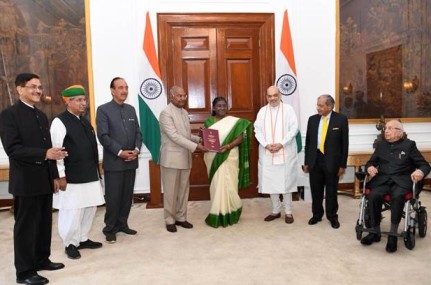In a landmark move aimed at revolutionizing India’s electoral process, the High-Level Committee (HLC) on Simultaneous Elections, under the seasoned leadership of Shri Ram Nath Kovind, former President of India, presented a comprehensive report to the Hon’ble President, Shrimati Droupadi Murmu. The voluminous document, spreading over 18,626 pages, encapsulates the findings from in-depth consultations with a wide array of stakeholders, experts, and an extensive research spanning 191 days since its formation on September 2, 2023.
High level Committee submits its report on One Nation, One Election- Simultaneous Elections core to Aspirational India
The committee’s assembly includes illustrious figures such as Shri Amit Shah, Union Minister of Home Affairs; Shri Ghulam Nabi Azad, the former Leader of Opposition in the Rajya Sabha; Shri N.K. Singh, the former Chairman of the 15th Finance Commission; Dr. Subhash C. Kashyap, the former Secretary-General of the Lok Sabha; Shri Harish Salve, Senior Advocate; and Shri Sanjay Kothari, former Chief Vigilance Commissioner. Alongside, Shri Arjun Ram Meghwal, Minister of State (Independent Charge) Ministry of Law and Justice participated as a Special Invitee, with Dr. Niten Chandra serving as the Committee’s Secretary.
Broad-based Stakeholder Engagement
The HLC undertook a monumental task of gathering inputs from diverse quarters, successfully receiving responses from 47 political parties, out of which 32 endorsed the idea of simultaneous elections. A public notice encouraged a flood of suggestions, with 21,558 citizens overwhelmingly supporting the move. In addition, high-ranking law experts, including former Chief Justices of major courts and Chief Election Commissioners, provided invaluable insights through personal interactions.
Economic Rationale
The call for concurrent elections found resonance not just among political entities and legal luminaries but also within the corporate sector. Leading business conglomerates and esteemed economists highlighted the financial logic behind synchronized elections, stressing how staggered elections exacerbate inflation and hinder economic momentum. Their analyses underscored the detrimental effects of asynchronous elections on India’s GDP growth, fiscal management, and social fabric.
A Two-Pronged Approach to Implementation
After meticulous evaluation of all inputs, the High-Level Committee outlined a strategic, two-step method to initiate simultaneous elections across the country. The proposal envisages initial synchronized elections for the Lok Sabha and the State Legislative Assemblies, followed by aligning Municipal and Panchayat elections within a hundred days of the national and state polls. This phased integration aims to streamline the electoral process, making it more efficient and less disruptive.
Towards a Unified Electoral Infrastructure
The report further recommends the adoption of a unified electoral roll and the Electoral Photo Identity Cards (EPIC) system for all tiers of government elections. This measure is expected to simplify the voting process, reduce redundancy, and enhance the accuracy of electoral rolls.
Constitutional Fidelity and Recommended Amendments
Underscoring its commitment to respecting the constitutional framework, the High-Level Committee’s recommendations propose minimal amendments to ensure the seamless transition to simultaneous elections. The suggested changes reflect a deep understanding of India’s constitutional ethos and an earnest effort to align the electoral reforms within its bounds.
Impact and Future Projections
The High-Level Committee believes that the unanimous implementation of its recommendations will significantly benefit India’s electoral and democratic framework by improving transparency, inclusivity, and voter convenience. The anticipated reforms promise to accelerate development, foster social unity, and strengthen the democratic principles that form the bedrock of the nation.
As the report now awaits further deliberation by legislative bodies, its recommendations herald a potentially transformative phase in India’s electoral history, setting a precedent for democratic practices globally. The move towards simultaneous elections is seen as a positive stride towards realizing the aspirations of a vibrant, inclusive, and forward-looking India.
Read More: Ministry of Information & Broadcasting takes Action against Obscene Content on OTT Platforms

